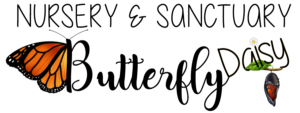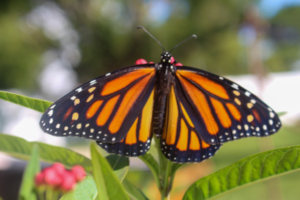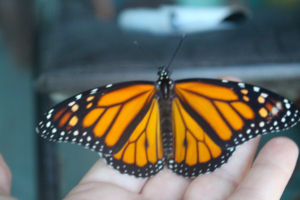What to avoid if you want butterflies
Here are a few things you should avoid if you want butterflies visiting your backyard:
- Shade
- Growing only nectar or only host plants
- Pesticides
- Neem oil
- Insecticide soap
- Red flowers (Some butterflies cannot see the color red. Instead, look for nectar-bearing flowers that are bright yellow, pink, white, orange, and purple.)
- Plants from outside of your hardiness zone.
Why design a butterfly garden?
Butterfly conservation is important for ensuring the health and enrichment of wildlife and the environment.
Butterflies are threatened by habitat destruction as suburbs and cities across the country expand, wildfires rage on, and deforestation continues. Building a butterfly garden helps to mitigate their displacement and invites them to your yard to entertain you and help your plants thrive.
Butterflies contribute to your local ecosystem through pollination. Butterflies pollinate your garden and flowers, an essential part of the life cycle for both plants and butterflies.
Planting native plants for your butterfly garden helps support your local ecosystem and attracts a variety of butterflies to your backyard.
Select a prime location
Butterflies love to bask in the sun, so make sure you find a full-sun area in your backyard. They are cold-blooded, meaning they cannot regulate their temperature. A sunny spot is imperative for creating a welcoming environment for butterflies to bask in.
Ensure that your butterfly garden gets at least six hours of direct sunlight per day. It’s also a great idea to place flat rocks around for butterflies to relax and catch some rays.
2. Learn about butterflies in your area
When choosing what to incorporate in your butterfly garden, you’ll want to focus on providing an environment and planting flowers that will attract butterfly species that already live in your area. It can be hard to figure out what to plant since there are hundreds of species of butterflies in the United States and thousands across the world.
3. Choose the right plants
To build a thriving butterfly garden, you’ll need to include both nectar plants and host plants.
- Nectar plants provide a source of food for adult, migrating butterflies. These are typically brightly-colored flowers with shallow blossoms.
- Host plants are where butterflies will lay their eggs. They provide a source of food for growing larvae. Caterpillars rarely do enough damage to host plants to harm or kill them.
Select plants that grow at a different range of heights and bloom at different times of the year. Some butterflies will seek out nectar from tall flowers, and others will look for shorter flowers. You can add levels by growing vines on a trellis or by potting flowers and hanging them from an outdoor structure.
Your local butterfly species will most likely be attracted to plants native to your region. It’s important to grow a variety of native species in your butterfly garden because butterflies can be picky about where they’ll eat and lay their eggs.
A diverse selection of native plants will lead to a diverse population of butterflies and caterpillars.
Common butterfly-friendly “nectar” plants
Perennials
- Anise hyssop (Agastache foeniculum)
- Butterfly weed* (Asclepias tuberosa)
- Common milkweed* (Asclepias syriaca)
- English lavender (Lavandula angustifolia)
- New England Aster* (Symphyotrichum novae-angliae)
- Purple coneflower (Echinacea purpurea)
- Purple passionflower* (Passiflora incarnata)
- Scarlet beebalm (Monarda didyma)
- Tall blazing star (Liatris aspera)
- Wild petunia* (Ruellia nudiflora)
Shrubs
- Butterfly bush (Buddleja marrubiifolia)
- Southern arrowwood* (Viburnum dentatum)
- Texas lantana (Lantana urticoides)
- Virginia willow (Itea virginica)
- Yellow Zinnia (Zinnia grandiflora)
Annuals
- Black-eyed Susan* (Rudbeckia hirta)
- Northern bog violet* (Viola nephrophylla)
- Skunkweed* (Cleome serrulata)
- Texas bluebonnet* (Lupinus texensis)
*Indicates the plant is also a host plant
Common caterpillar-friendly “host” plants
Perennials
- Anise hyssop (Agastache foeniculum)
- Butterfly weed* (Asclepias tuberosa)
- Common milkweed* (Asclepias syriaca)
- English lavender (Lavandula angustifolia)
- New England Aster* (Symphyotrichum novae-angliae)
- Purple coneflower (Echinacea purpurea)
- Purple passionflower* (Passiflora incarnata)
- Scarlet beebalm (Monarda didyma)
- Tall blazing star (Liatris aspera)
- Wild petunia* (Ruellia nudiflora)
Shrubs
- Butterfly bush (Buddleja marrubiifolia)
- Southern arrowwood* (Viburnum dentatum)
- Texas lantana (Lantana urticoides)
- Virginia willow (Itea virginica)
- Yellow Zinnia (Zinnia grandiflora)
Annuals
- Black-eyed Susan* (Rudbeckia hirta)
- Northern bog violet* (Viola nephrophylla)
- Skunkweed* (Cleome serrulata)
- Texas bluebonnet* (Lupinus texensis)
*Indicates the plant is also a host plant
Common caterpillar-friendly “host” plants
| Plant: | Larval host of: |
| Butterfly weed | Grey hairstreak, Monarch, Queen |
| Black-eyed Susan | Gorgone Checkerspot, Bordered patch |
| Cabbage | Cabbage White |
| Carrot | Black Swallowtail |
| Clover | Orange sulphur |
| Common milkweed | Monarch |
| Cottonwood | Tiger swallowtail, Viceroy |
| Dill | Black swallowtail |
| New England Aster | Pearl crescent, Checkerspot |
| Northern bog violet | Nokomis fritillary |
| Purple passionflower | Red-banded hairstreak, Mexican butterfly, Zebra Longwing |
| River birch | Tiger swallowtail |
| Skunkweed | Checkered white |
| Southern arrowwood | Spring Azure |
| Texas bluebonnet | Hairstreak, Elfin |
| Wild black cherry | Tiger swallowtail |
| Wild petunia | Common buckeye, White peacock |
| Willow | Tiger swallowtail, Viceroy |
5. Incorporate butterfly shelter
Butterflies need access to shelter in harsh weather, such as heavy rain or wind. Butterflies are more attracted to natural coverage than colorful butterfly houses, and butterfly houses are actually more inviting to pests such as paper wasps.
To prevent unwanted wasp colonies from making a home in your garden, opt for more natural butterfly shelter such as:
- Stacked wood
- Rock piles
- Dense shrubs
- Trees (dead or alive)
- Tall grass
6. Create an area for butterfly puddling
What is puddling?
Puddling is a common behavior for butterflies and other insects where they seek out moist areas to perch and ingest water through their proboscis.
Butterflies need access to shallow puddles of water to stay hydrated and get access to key minerals and nutrients. Some butterflies even live exclusively in boggy areas, such as the Sleepy Orange Butterfly and the Cloudless Sulphur.
You can create an artificial puddling station by placing a shallow dish filled with sand or pebbles and water somewhere within your butterfly garden. This is sometimes called a “butterfly bath” as it’s a smaller, more shallow version of a birdbath.
7. Keep an eye on your soil conditions
If you want a garden full of beautiful butterflies, your soil must be free of chemicals, especially if butterflies will be puddling directly on the ground.
Most pesticides will threaten butterflies (and even bees). Even organic options such as neem oil and insect-repelling soap will repel butterflies, mess up their feeding habits, and disrupt their mating process.
Avoid using unnecessary pesticides, and only use them when needed. By avoiding preventative pesticide applications, you’re giving butterflies a healthy environment to thrive.
Instead of using pesticides, use alternative insect control methods, such as:
- Floating row covers
- Hand-picking large insects
- Water jets
Common butterflies in the U.S.
Some of the most common butterflies in America include:
| Butterfly | Host plants |
| Tiger Swallowtail (Papilio glaucus) | Cottonwood, birch, ash, wild black cherry, tulip tree, sweet bay (magnolia), willow |
| Black Swallowtail (Papilio polyxenes) | Carrot, Queen Anne’s lace, dill, parsley |
| Cabbage White (Pieris rapae) | Cabbage, broccoli, cauliflower, radishes, horseradish, nasturtiums |
| Orange Sulphur (Colias eurytheme) | Vetch, clover, alfalfa |
| Monarch (Danaus plexippus) | Milkweed, butterfly weed |
| Viceroy (Limenitis archippus) | Cottonwood, willow, aspen, cherry, plum, apple |
FAQ about butterflies
1. What is the life cycle for butterflies?
Butterflies have four life stages: egg, larvae, pupa, and adulthood.
Their life cycle length will depend on the species, but for most butterflies, after three to seven days, the butterfly egg will hatch into a larva or caterpillar.
Butterflies stay in the larvae stage for two to five weeks, then form a chrysalis and begin their pupa stage. The pupal stage differs in length depending on the species, lasting between weeks and years.
Most butterfly species have an adult stage that lasts about two weeks long.
2. How do butterflies help the environment?
Butterflies are pollinators, meaning they carry pollen from the stamen to the stigma of the same (or another) flower, fertilizing it. Pollination is essential for the plant reproduction process.
They also eat weedy plants and are a source of food for other wildlife.
3. What are their predators?
Wasps and flies are the enemies of butterfly larvae. They are also threatened by spiders, ants, and birds. Adult butterflies are more threatened by reptiles and bats. Other predators include rats, parasitic flies, toads, and dragonflies.
4. When will I see butterflies in my garden?
When you might find butterflies in your garden is largely dependent on where you live and the kind of plants you put in your butterfly garden.
Plants have different bloom times and different species are attracted to different nectar sources. That’s why it’s important to plant different types of native plants to attract a variety of butterflies.
Butterflies usually emerge during the morning and bask in the sun through hot afternoons. They prefer hot, humid weather, so summer is typically the peak season for you to find butterflies in your garden. Butterflies will migrate or hibernate in colder temperatures, so you won’t easily find them fluttering around during the winter.



